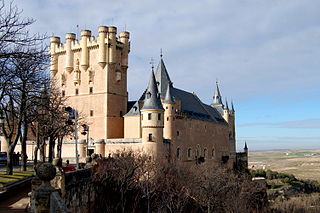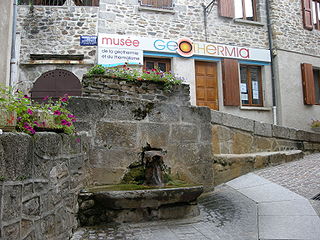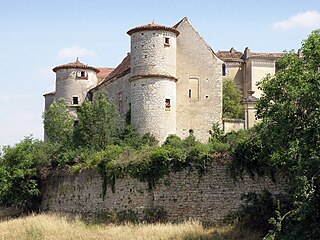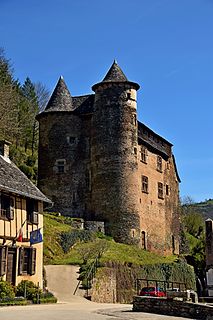
The Château de Couffour or Tour du Couffour is a ruined castle situated in the French commune of Chaudes-Aigues in the Cantal département . [1]

A castle is a type of fortified structure built during the Middle Ages by predominantly the nobility or royalty and by military orders. Scholars debate the scope of the word castle, but usually consider it to be the private fortified residence of a lord or noble. This is distinct from a palace, which is not fortified; from a fortress, which was not always a residence for royalty or nobility; and from a fortified settlement, which was a public defence – though there are many similarities among these types of construction. Usage of the term has varied over time and has been applied to structures as diverse as hill forts and country houses. Over the approximately 900 years that castles were built, they took on a great many forms with many different features, although some, such as curtain walls and arrowslits, were commonplace.
The commune is a level of administrative division in the French Republic. French communes are analogous to civil townships and incorporated municipalities in the United States and Canada, Gemeinden in Germany or comuni in Italy. The United Kingdom has no exact equivalent, as communes resemble districts in urban areas, but are closer to parishes in rural areas where districts are much larger. Communes are based on historical geographic communities or villages and are vested with significant powers to manage the populations and land of the geographic area covered. The communes are the fourth-level administrative divisions of France.

Chaudes-Aigues is a commune in the Cantal department in south-central France. It is a spa town, famous for its hot spring waters.
Contents
The original 15th-century castle, with seven towers with conical roof, was witness to the importance of this place during the Hundred Years War. The present remains consist of a tower and neighbouring buildings. The circular tower has attached to it, on the west, a smaller tower containing the spiral staircase that gives access to the upper floors. The ground floor, noticeably square, is vaulted. The rooms on the three upper floors display a more or less similar layout. Small circular rooms communicate with each of these rooms. On the first floor, one room still has 17th-century paintings where, on a background of bouquets of leaves and flowers, are inset portraits of women and landscapes in rectangular frames. The first floor room has an 18th-century painted wooden fireplace. [1]
In the 18th century, the castle was sold to a local owner. The French Revolution and the early 19th century were a period of decline; poorly maintained, the castle fell into disrepair. Now the property of the commune of Chaudes-Aigues, Château de Couffour is listed as a monument historique by the French Ministry of Culture. [1]

The French Revolution was a period of far-reaching social and political upheaval in France and its colonies beginning in 1789. The Revolution overthrew the monarchy, established a republic, catalyzed violent periods of political turmoil, and finally culminated in a dictatorship under Napoleon who brought many of its principles to areas he conquered in Western Europe and beyond. Inspired by liberal and radical ideas, the Revolution profoundly altered the course of modern history, triggering the global decline of absolute monarchies while replacing them with republics and liberal democracies. Through the Revolutionary Wars, it unleashed a wave of global conflicts that extended from the Caribbean to the Middle East. Historians widely regard the Revolution as one of the most important events in human history.

Monument historique is a designation given to some national heritage sites in France. It may also refer to the state procedure in France by which National Heritage protection is extended to a building, a specific part of a building, a collection of buildings, garden, bridge, or other structure, because of their importance to France's architectural and historical cultural heritage. Both public and privately owned structures may be listed in this way, as well as also movable objects. As of 2012 there were 44,236 monuments listed.
Since 2009, the castle has been a hotel-restaurant with 2 stars in the Michelin Guide, under Serge Vieira, winner of the Bocuse d'Or in 2005. [2]

Michelin Guides are a series of guide books published by the French tire company Michelin for more than a century. The term normally refers to the annually published Michelin Red Guide, the oldest European hotel and restaurant reference guide, which awards up to three Michelin stars for excellence to a select few establishments. The acquisition or loss of a star can have dramatic effects on the success of a restaurant. Michelin also publishes a series of general guides to cities, regions, and countries, the Green Guides.
The Bocuse d'Or is a biennial world chef championship. Named for the chef Paul Bocuse, the event takes place during two days near the end of January in Lyon, France at the SIRHA International Hotel, Catering and Food Trade Exhibition, and is one of the world's most prestigious cooking competitions.












